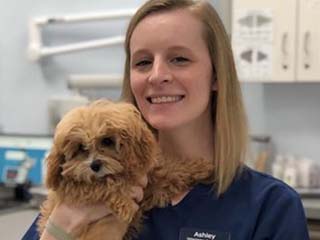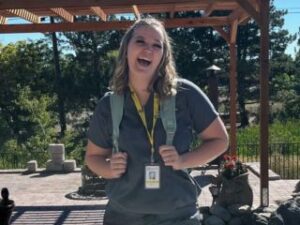 Ashley Wagaman put a great deal of thought and consideration into returning to school at the age of 34 to pursue a new career in Veterinary Technology (VT). She explored her options and made all her decisions carefully. She wanted a career that would maintain her interest over the long term while still providing her with employment options as she grew older. As a self-described “big nerd,” she knew that once she enrolled, she would be a serious student who was committed to school like it was a full-time job and so she needed to find the right veterinary technology program in the Bay Area to fit her personality and suit her needs. At Carrington College, San Leandro she found that program. Not just that—through a combination of her hard work and the Career Services provided by Carrington, she also found permanent employment as a VT in San Francisco.
Ashley Wagaman put a great deal of thought and consideration into returning to school at the age of 34 to pursue a new career in Veterinary Technology (VT). She explored her options and made all her decisions carefully. She wanted a career that would maintain her interest over the long term while still providing her with employment options as she grew older. As a self-described “big nerd,” she knew that once she enrolled, she would be a serious student who was committed to school like it was a full-time job and so she needed to find the right veterinary technology program in the Bay Area to fit her personality and suit her needs. At Carrington College, San Leandro she found that program. Not just that—through a combination of her hard work and the Career Services provided by Carrington, she also found permanent employment as a VT in San Francisco.
It was 2012 when Ashley followed her heart across the United States from Philadelphia, Pennsylvania to San Francisco, California. Her boyfriend lived there and they had been in a long-distance relationship for two years. She knew from previous visits that she loved the West Coast culture, beauty of the Bay, and California way of life. So, she moved in with him, and soon after they settled into their new life together, she started working in banking. It’s not that she was passionate about banking—it simply was work that helped pay the bills. She spent some time in college when she was younger but never settled on a specific career path.
“I spent most of my life not clear on what I wanted to do,” she said.
About three years after she arrived in San Francisco, Ashley was looking for activities outside of work, so she started volunteering at a senior cat rescue.
“I would go in and feed them and clean their little cat condos and do some education with the public that would come in and be interested in adoption. After I did that for a while, I was looking for a career change and I just impulsively applied at an animal hospital as a receptionist. From there, vet med just kind of clicked because I spent a large portion of my life not really knowing what I wanted to do and not having a clear direction professionally. Once I spent more time in vet med, it became even more apparent that is where I am supposed to be.”
While working at the veterinary hospital, she quickly became familiar with the roles and responsibilities of the employees. This made her increasingly interested in becoming a VT. There was just one thing—she was a bit concerned about the physical demands of the job long-term and whether there will be opportunities for her as she grows older and eventually needs lighter physical duties. VTs in veterinary clinics frequently stand, walk, carry, push, and pull to maneuver patients on stretchers and tables for exams and surgeries. This might not be difficult with a 10-pound dog but with one that weighs 80 or 135 pounds, it is more challenging.
When she took a closer look at the profession, Ashley was excited to find that VTs have opportunities in a variety of locations, including zoo animal care, injured wildlife rehabilitation, biomedical research laboratories, and schools—to name just a few places. At research facilities and labs, they often prepare slides for microscopes, which would require fine motor skills but be less physically strenuous. Then at schools, experienced VTs who excel in leadership can teach students who are on their way to starting their careers. She figured that those would be a couple less physically strenuous options that she could pursue as she grew older.
The pieces were coming together—VT was a career that both interested Ashley and had long-term promise. She decided it was time to start looking at schools and programs. One of her coworkers went to Carrington and highly recommended the VT program to her. Ashley liked the location, which was accessible to her via public transportation, and the hands-on style of the curriculum. She was also excited by the offerings of the Career Services department. In particular, she was impressed by their help with finding externships and employment.
“I know in some other schools’ programs you have to go out and find your internships and externships independently. That just seems so daunting to me to have to do all of that legwork of having to basically cold call clinics and say basically, ‘hey, can I come spend time with you?’ It was important that I had that framework and that structure from the school so I could just focus on learning the material,” she said.
Carrington provides each student with a Career Services Advisors who works with them to find learning opportunities at veterinary practices in the community through internships, externships, and permanent positions after graduation.
Ashley’s inner “big nerd” quickly found a cheerful home within Carrington’s VT program. Studying pathology and disease processes especially intrigued her. If there was a blood smear on a slide under a microscope, she wanted to see it. Anatomy and physiology, as well as microbiology, also quickly became favorites. Then there was the intriguing interconnectedness of veterinary medicine and public health with controlling zoonotic diseases, such as rabies, Lyme disease, plague, salmonella, and emerging coronaviruses, including the one that causes COVID19. Everything she learned fed her curiosity and passion for veterinary medicine.
She emphasized that she was fortunate to have a supportive partner while in school and said, “I am in a unique position where school is all I need to focus on right now, so I study a lot. If I am on the train, I am studying. If I am sitting down in the evening, I am studying. I study all the time. Of course, it helps if you like what you are studying.”
The many hours she has spent reading and memorizing information has paid off in high test scores. She has also garnered attention in the classroom because of how great she is at teaching other students. Both of her parents have taught during their lives, so it appears they modeled great teaching skills and passed on the right genes to Ashley. Her Carrington instructor, Ms. Hansen, went further and said, “Ashley is an open-minded, kind, approachable, simply stellar student, and has been right from the start. She was the first-ever student to get a full 1000/1000 at the end of a term in one of our longer-term instructor’s histories with us here at Carrington (16 years)! My jaw dropped when I heard that—VT school is hard! She has been a great mentor to her peers and loves to teach. The instructors are hoping she returns as an instructor herself someday!”
Ashley’s hard work and deep knowledge also led to a part-time Veterinary Assistant position at The Castro Animal Hospital in San Francisco’s Duboce Triangle neighborhood during her second internship. The practice has four full-time veterinarians and one part-time. She said she was “over the moon” when she was hired and intends on increasing her hours to full-time during her externship period over the fifth and final term coming up next. Then she will stay as a permanent employee and VT after graduation. After she gains more experience in the field, Ashley intends on adding teaching to her repertoire.
She said, “I think I’ve been bitten by the teaching bug, which is not surprising because my mom worked as a teacher’s aide throughout her career and so I think it’s just in my blood… then my dad did a lot of the training and career development for his job.”
It is also very important to Ashley to help destigmatize conversations about mental health in the veterinary medicine field. Historically, mental health has been a taboo subject, but progress has been made in recent years to open the conversation. Animal medicine involves interacting with people during difficult times in their lives when their pets may be sick or dying and they are facing difficult decisions and emotions. Providing that level of support without also receiving support behind the scenes can take a toll on the mental health of people who work in veterinary medicine, resulting in something called “compassion fatigue.” Compassion fatigue is a form of traumatic stress that makes it difficult to care for oneself and others. Thankfully, a supportive community and access to helpful tools and information can help to alleviate and prevent compassion fatigue from developing. Ashley intends on being part of the pro-active conversation on mental health so she can help others in her field.
The well-researched decisions Ashley made to become a VT and go to Carrington College combined well with her academic focus and collegial attitude. Career Services helped her in the ways that she hoped they would so she could focus on studying. She wasn’t stuck cold-calling veterinary practices searching for opportunities to get experience. Her career services counselor worked on that while she read and memorized in preparation for tests. They secured her an internship that turned into employment, and she will graduate at the end of her next term with a full-time position.
Before long, her passion for teaching will bring her back to the classroom, where she will lead and teach students who went through their own processes to decide on a career in veterinary technology. If they are fortunate, Ashley just might give them insight on how to ace a test.



